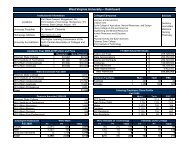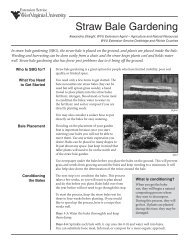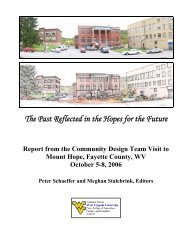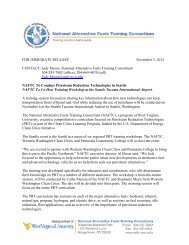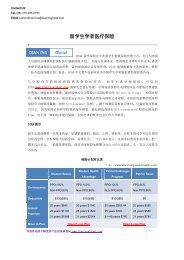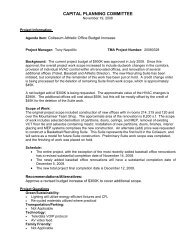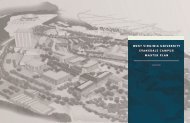gaseous fuels and gaseous fuel vehicles
gaseous fuels and gaseous fuel vehicles
gaseous fuels and gaseous fuel vehicles
Create successful ePaper yourself
Turn your PDF publications into a flip-book with our unique Google optimized e-Paper software.
Clean Cities Learning Program<br />
U.S. STATISTICS<br />
Alternative Fuel<br />
Number of<br />
<strong>vehicles</strong> in use<br />
(2008) a<br />
FACT SHEET<br />
Total annual <strong>fuel</strong><br />
use in <strong>vehicles</strong><br />
(2008) a<br />
CNG 113,973 189,358 GGEs c<br />
Alternative Fuel <strong>and</strong> Advanced Technology Vehicles<br />
Curricula, Training, <strong>and</strong> Education <strong>and</strong> Outreach Activities<br />
FIRST RESPONDER SAFETY: GASEOUS FUELS AND GASEOUS FUEL VEHICLES<br />
GASEOUS FUELS<br />
Compressed natural gas (CNG), liquefied natural gas (LNG), <strong>and</strong><br />
liquefied petroleum gas (LPG), more commonly referred to as<br />
propane, are <strong>gaseous</strong> alternative <strong><strong>fuel</strong>s</strong>, as defined by the Energy<br />
Policy Act of 1992.<br />
Natural Gas. Natural<br />
gas is an odorless, nontoxic,<br />
non-corrosive,<br />
non-carcinogenic<br />
<strong>gaseous</strong> mixture of<br />
hydrocarbons <strong>and</strong> other<br />
gases. Most natural gas<br />
is extracted from wells<br />
or in conjunction with<br />
Natural gas vehicle emblem. Source: NAFTC crude oil production.<br />
Smaller amounts are derived as biogas, a renewable form of natural<br />
gas, from decaying organic materials, such as waste from l<strong>and</strong>fills.<br />
Natural gas accounts for approximately 25% of the energy used<br />
in the United States. Of this, only about 0.1% is currently used for<br />
transportation <strong>fuel</strong>. Because of the <strong>gaseous</strong> nature of this <strong>fuel</strong>, it<br />
must be stored on board a vehicle in either a<br />
compressed <strong>gaseous</strong> or liquefied state.<br />
CNG: To provide adequate driving range, CNG<br />
must be stored onboard a vehicle in tanks at<br />
high pressure.<br />
LNG: To produce LNG, natural gas is purified <strong>and</strong><br />
condensed into liquid by cooling it.<br />
Propane. Propane is a three-carbon alkane<br />
gas produced as a byproduct of natural gas<br />
processing <strong>and</strong> crude oil refining. When<br />
stored under pressure in a tank, propane<br />
becomes a colorless, odorless liquid. As pressure is released, the<br />
liquid propane vaporizes <strong>and</strong> turns into gas that is then used for<br />
combustion. An odorant is added to propane for leak detection.<br />
It accounts for about 2% of the energy used in the United States;<br />
however, less than 2% of U.S. propane consumed is used for<br />
transportation <strong>fuel</strong>.<br />
Total <strong>fuel</strong>ing<br />
stations<br />
(May 2010) b<br />
LNG 3,101 25,554 GGEs 38<br />
Propane 151,049 147,784 GGEs 2,403<br />
a U.S. Energy Information Administration, Alternatives to Traditional Transportation Fuels 2008.<br />
b U.S. Department of Energy, Alternative Fuels & Advanced Vehicles Data Center (AFDC).<br />
c GGE: Gasoline gallon equivalent.<br />
1Clean Vehicle Education Foundation (2008), Technology Committee Bulletin: How Safe are Natural Gas Vehicles?<br />
GASEOUS FUEL VEHICLES<br />
Gaseous <strong><strong>fuel</strong>s</strong> are used in passenger <strong>vehicles</strong> through heavy-duty<br />
vehicle applications. Vehicles that run on LNG, CNG, or propane<br />
operate in the same way as conventional <strong>vehicles</strong>, <strong>and</strong> include<br />
an internal combustion engine (ICE), transmission, drive train,<br />
<strong>and</strong> <strong>fuel</strong> storage system, but require some modification to the<br />
engine calibration <strong>and</strong> <strong>fuel</strong> management systems (primary <strong>fuel</strong><br />
storage systems). The ICE converts <strong>fuel</strong> into mechanical energy<br />
<strong>and</strong> operates in much the same manner as the ones found in<br />
conventional gasoline <strong>vehicles</strong>.<br />
Gaseous <strong>fuel</strong> <strong>vehicles</strong> may be configured in one of three ways:<br />
dedicated, bi-<strong>fuel</strong>, or dual-<strong>fuel</strong>. Dedicated <strong>vehicles</strong> run on only<br />
one alternative<br />
<strong>fuel</strong>. Bi-<strong>fuel</strong><br />
<strong>vehicles</strong> can<br />
run on either<br />
alternative <strong>fuel</strong><br />
or gasoline.<br />
Dual-<strong>fuel</strong><br />
<strong>vehicles</strong> run on<br />
alternative <strong>fuel</strong><br />
(natural gas)<br />
<strong>and</strong> use diesel<br />
Propane vehicle. Source: NAFTC<br />
VEHICLE SAFETY<br />
As with all www.naftc.wvu.edu/cleancitieslearningprogram<br />
<strong><strong>fuel</strong>s</strong>, natural gas <strong>and</strong> propane are flammable, but <strong>gaseous</strong> <strong>fuel</strong> <strong>vehicles</strong> meet National the Alternative Fuels<br />
www.cleancities.energy.gov<br />
Training Consortium<br />
same safety st<strong>and</strong>ards as conventional <strong>vehicles</strong>. However, only properly trained personnel with<br />
A Program of<br />
the appropriate protective National gear Alternative should Fuels approach Training Consortium a vehicle in the case of an incident. First<br />
Ridgeview Business Park, 1100 Frederick Lane, Morgantown, WV 26508<br />
responders must underst<strong>and</strong> the different 304-293-7882components<br />
that make these <strong>vehicles</strong> unique in an<br />
emergency situation.<br />
836<br />
for ignition<br />
assist. Light-<br />
duty <strong>vehicles</strong> typically operate in dedicated or bi-<strong>fuel</strong> modes, <strong>and</strong><br />
heavy-duty <strong>vehicles</strong> operate in dedicated or dual-<strong>fuel</strong> modes.<br />
VEHICLE SAFETY<br />
As with all <strong><strong>fuel</strong>s</strong>, natural gas <strong>and</strong> propane are flammable,<br />
but <strong>gaseous</strong> <strong>fuel</strong> <strong>vehicles</strong> meet the same safety st<strong>and</strong>ards as<br />
conventional <strong>vehicles</strong>. First responders must underst<strong>and</strong> the<br />
different components that make these <strong>vehicles</strong> unique in an<br />
emergency situation.<br />
Natural Gas. Natural gas vehicle (NGV) <strong>fuel</strong> tanks are strong<br />
<strong>and</strong> extremely puncture resistant. In addition, NGVs must meet<br />
the National Fire Protection Association’s (NFPA) NFPA 52<br />
Vehicular Fuel System Code.
Clean Cities Learning Program FACT SHEET Gaseous Fuels <strong>and</strong> Gaseous Fuel Vehicles<br />
Based on a survey of over 8,300 natural gas fleet <strong>vehicles</strong> that traveled over 175 million miles:<br />
• The NGV injury rate was 37% lower when compared to gasoline fleet <strong>vehicles</strong>;<br />
• There were no fatalities compared with 1.28 deaths per 100 million miles for gasoline fleet <strong>vehicles</strong>;<br />
• Vehicles were only involved in seven fire incidents, only one of which was directly attributable to failure of the natural gas<br />
<strong>fuel</strong> system. 1<br />
Propane. Propane tanks are 20 times more puncture resistant than gasoline tanks, <strong>and</strong> propane in its liquid state has the lowest<br />
flammability range of all alternative <strong><strong>fuel</strong>s</strong>. Because it becomes a gas when leaked, however, propane is more likely to ignite<br />
than other liquid <strong><strong>fuel</strong>s</strong>; leaked propane gas can fill a room <strong>and</strong> form a flammable layer against the ground or floor. If stored in<br />
an enclosed space, proper ventilation <strong>and</strong> leak detection sensors are needed to increase safety, as the gas can displace the air<br />
necessary for breathing.<br />
FIRST RESPONDER INFORMATION<br />
Important considerations when responding to an incident involving a <strong>gaseous</strong> <strong>fuel</strong> vehicle include:<br />
• Be sure to identify whether the vehicle is powered by CNG, LNG, or propane.<br />
• Approach the vehicle with caution <strong>and</strong> only with the appropriate training.<br />
• Eliminate all ignition sources.<br />
• Stay upwind of vapors.<br />
• Look, smell, listen, feel <strong>and</strong>/or use sensors to detect leaking <strong>fuel</strong> or a fire.<br />
o If no fire or leak is detected, isolate the <strong>fuel</strong> system.<br />
In the case of a vehicle fire:<br />
• If the vehicle is on fire or a leak is detected, do not approach the vehicle.<br />
• Isolate the fire, if possible.<br />
• Extinguish the fire.<br />
• Be aware that, if the flame is extinguished without stopping <strong>fuel</strong> flow, the fire<br />
may re-ignite.<br />
In the case of <strong>fuel</strong> spill or leak, eliminate all ignition sources <strong>and</strong> use water<br />
spray to reduce vapors or divert vapor cloud drift.<br />
If extrication is necessary:<br />
• Be sure there are no leaks or vapors that could ignite<br />
• Know cribbing points <strong>and</strong> cut zones before cutting into a vehicle.<br />
• Avoid cutting critical components.<br />
Natural gas vehicle re<strong>fuel</strong>ing. Source: NAFTC<br />
www.cleancities.energy.gov<br />
The U.S. DOE Clean Cities Program is a government-industry partnership designed to reduce petroleum<br />
consumption in the transportation sector by advancing the use of alternative <strong><strong>fuel</strong>s</strong> <strong>and</strong> <strong>vehicles</strong>, idle<br />
reduction technologies, hybrid electric <strong>vehicles</strong>, <strong>fuel</strong> blends, <strong>and</strong> <strong>fuel</strong> economy measures.<br />
Propane decal on a school bus. Source: NAFTC<br />
ADDITIONAL RESOURCES<br />
• U.S. Department of Energy, Alternative Fuels<br />
& Advanced Vehicles Data Center:<br />
http://www.afdc.energy.gov/afdc/<br />
• Clean Vehicle Education Foundation:<br />
http://www.cleanvehicle.org/<br />
• Natural Gas Vehicles for America:<br />
http://www.ngvc.org/<br />
• Propane Education & Reserach Council:<br />
http://www.propanecouncil.org/<br />
• National Fire Protection Association:<br />
http://www.nfpa.org/<br />
www.naftc.wvu.edu/cleancitieslearningprogram<br />
The National Alternative Fuels Training Consortium is the<br />
only nationwide alternative <strong>fuel</strong> vehicle <strong>and</strong> advanced<br />
technology vehicle training organization in the U.S.<br />
Acknowledgment: This material is based upon work supported by the U.S. Department of Energy Clean Cities Program under Award Number DE-EE0001696.





